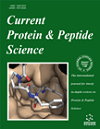- Home
- A-Z Publications
- Current Protein and Peptide Science
- Previous Issues
- Volume 16, Issue 6, 2015
Current Protein and Peptide Science - Volume 16, Issue 6, 2015
Volume 16, Issue 6, 2015
-
-
Integrase Interactor 1 in Health and Disease
More LessBy Supratik DasIntegrase interactor 1 (INI1/hSNF5) is a core component of the SWI/SNF chromatin remodeling complex that alters the structure of chromatin in order to facilitate DNA-dependent cellular processes like transcription, replication, and repair. Integrase interactor 1 (INI1/hSNF5) is a core component of the SWI/SNF chromatin remodeling complex that alters the structure of chromatin in order to facilitate DNA-dependent c Read More
-
-
-
ADP-Ribosyltransferases and Poly ADP-Ribosylation
More LessAuthors: Chao Liu and Xiaochun YuProtein ADP-ribosylation is an important posttranslational modification that plays versatile roles in multiple biological processes. ADP-ribosylation is catalyzed by a group of enzymes known as ADP-ribosyltransferases (ARTs). Using nicotinamide adenine dinucleotide (NAD+) as the donor, ARTs covalently link single or multiple ADP-ribose moieties from NAD+ to the substrates, forming mono ADP-ribosylation or poly ADP-ribosylat Read More
-
-
-
The Aromatic Stacking Interactions Between Proteins and their Macromolecular Ligands
More LessAuthors: Mohammad Mizanur Rahman, Ziyad Tariq Muhseen, Muhammad Junaid and Houjin ZhangAromatic stacking interactions arise from the attractive force between the π-electron clouds in the neighboring aromatic groups. The aromatic stacking is common between proteins and small molecules. The stacking interactions at the interfaces of proteins and other macromolecules are relatively rare. However it contributes to a significant portion of the stabilizing forces. In the proteinprotein complexes, aromatic interact Read More
-
-
-
Reshaping the Protein Folding Pathway by Osmolyte via its Effects on the Folding Intermediates
More LessIt is now well established that the protein folding reaction proceeds via accumulation of various intermediate states. Osmolytes, besides their role in protein stabilization, have also been shown to possess the ability of inducing tremendous affects on these protein folding intermediates, reshape the folding pathway and the energy landscape. The present article describes the advances made so far in understanding the effects of o Read More
-
-
-
The Role of Structural Flexibility and Stability in the Interaction of Serine Proteases with their Inhibitors
More LessAuthors: Laszlo Graf, Tamas Molnar, Jozsef Kardos, Zoltan Gaspari and Gergely KatonaSerine proteases and their natural inhibitors have long been served as excellent models for studying (primary, secondary and tertiary) structure - activity relationships of biologically interacting proteins. As protein flexibility has been accepted as a “fourth dimension” of the protein structure, its contribution to the binding process has gained much interest. In this article we review extreme cases of serine protease interactions wit Read More
-
-
-
Disintegrins from Snake Venoms and their Applications in Cancer Research and Therapy
More LessAuthors: Jessica Kele Arruda Macedo, Jay W. Fox and Mariana de Souza CastroIntegrins regulate diverse functions in cancer pathology and in tumor cell development and contribute to important processes such as cell shape, survival, proliferation, transcription, angiogenesis, migration, and invasion. A number of snake venom proteins have the ability to interact with integrins. Among these are the disintegrins, a family of small, non-enzymatic, and cysteine-rich proteins found in the venom of numerou Read More
-
-
-
The Sactibiotic Subclass of Bacteriocins: An Update
More LessAuthors: Harsh Mathur, Mary C. Rea, Paul D. Cotter, Colin Hill and R. Paul RossThe sactibiotics are a recently designated subclass of bacteriocins that contain characteristic cysteine sulphur to α -carbon linkages mediated through post-translational modifications. They are a relatively small subclass of bacteriocins compared to the most thoroughly studied lantibiotics. The sactibiotics that have been extensively studied thus far are thuricin CD, subtilosin A, thurincin H, and propionicin F. Despite their rece Read More
-
-
-
Targeting EZH2 for Cancer Therapy: Progress and Perspective
More LessAuthors: Chi Han Li and Yangchao ChenEnhancer of Zeste Homolog 2 (EZH2) is the core component of the polycomb repressive complex 2 (PRC2), possessing the enzymatic activity in generating di/tri-methylated lysine 27 in histone H3. EZH2 has important roles during early development, and its dysregulation is heavily linked to oncogenesis in various tissue types. Accumulating evidences suggest a remarkable therapeutic potential by targeting EZH2 in cancer cel Read More
-
Volumes & issues
-
Volume 26 (2025)
-
Volume 25 (2024)
-
Volume 24 (2023)
-
Volume 23 (2022)
-
Volume 22 (2021)
-
Volume 21 (2020)
-
Volume 20 (2019)
-
Volume 19 (2018)
-
Volume 18 (2017)
-
Volume 17 (2016)
-
Volume 16 (2015)
-
Volume 15 (2014)
-
Volume 14 (2013)
-
Volume 13 (2012)
-
Volume 12 (2011)
-
Volume 11 (2010)
-
Volume 10 (2009)
-
Volume 9 (2008)
-
Volume 8 (2007)
-
Volume 7 (2006)
-
Volume 6 (2005)
-
Volume 5 (2004)
-
Volume 4 (2003)
-
Volume 3 (2002)
-
Volume 2 (2001)
-
Volume 1 (2000)
Most Read This Month
Article
content/journals/cpps
Journal
10
5
false
en


